Research at the Laboratory of Crystallography
Charge density waves in Er5Ir4Si10 and related compounds
The rare earth metal (R) transition metal silicides R5Ir4Si10 have complicated phase diagrams. They exhibit Charge-density wave (CDW) transitions at temperatures TCDW in the range 80 K < TCDW < 210 K, depending on the rare earth element R. At much lower temperatures phase transitions from paramagnetic to antiferromagnetic states have been found in the compounds with localized magnetic moments due to the f electrons on the R atoms, while non-magnetic compounds, e.g. with R = Lu, become superconducting.
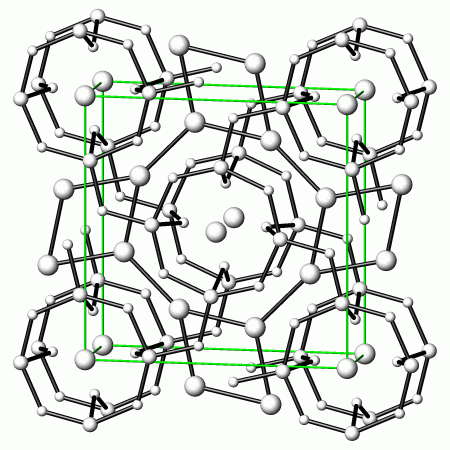
Fig. 1: All compounds R5Ir4Si10 crystallize in the Sc5Co4Si10 structure type with the tetragonal space group P4/mbm and with lattice parameters of approximately a = 12.5 and c = 4.2 A at room temperature. View of the basic structure approximately along the tetragonal c-axis. Large circles represent R atoms, intermediate circles are Ir, and small circles denote Si.
Temperature dependent x-ray diffraction was measured on single crystals of the compounds R5Ir4Si10 with R = Ho, Er, Tm, Lu, (Lu0.36Er0.64) and (Lu0.16Er0.84). Weak satellite reflections could be found due to the use of synchrotron radiation. The results show a remarkable variation of superstructures that allow the rationalization of the qualitatively different temperature dependencies of the physical properties in these compounds. In compounds with R = Ho, Er, Tm and (Lu0.16Er0.84) a commensurate CDW (q1 = 0.5 c*) and an incommensurate CDW (q2 = ±0.25 ±d c* with d = 0.03) simultaneously develop at TCDW, while commensurate CDWs (q = n/7 c*) develop in compounds with R = Lu and (Lu0.34Er0.66).
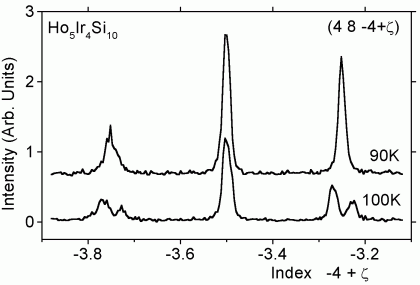
Fig. 2: q-scans of the positions of the satellite reflections of Ho5Ir4Si10 between (4, 8, -3.9) and (4, 8, -3.1). One scan in the incommensurate phase (T = 100 K) and one scan below the lock-in transition (T = 90 K) are shown.
A model was proposed that explains the simultaneous occurrence of commensurate and incommensurate modulations at TCDW [1]. In this model a structural phase transition towards a doubled unit cell is supposed to take place at TCDW. The modified electronic band-structure of this superstructure then provides the proper nesting conditions for the incommensurate CDW [1]. This model was supported by the observation of diffuse scattering above TCDW for the commensurate satellites only [2], and by the anomalous increase of the electrical resistivity below TCDW.
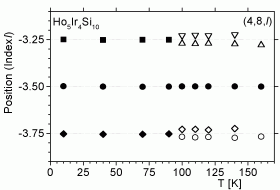
Fig. 3: Temperature dependence of the positions of the satellite reflections in the x-ray diffraction of Ho5Ir4Si10 on the line (4, 8, l) (left), and of Tm5Ir4Si10 on the line (5, -12, l) (right).
The compounds with an incommensurate CDW exhibit a second transition at Tlock-in < TCDW. In Ho5Ir4Si10 and Er5Ir4Si10 this is a pure lock-in transition at which d becomes zero. In Tm5Ir4Si10 and (Lu0.16Er0.84)5Ir4Si10 d also becomes zero, but additional satellite reflections appear. They are found at commensurate positions n/8 c* in Tm5Ir4Si10, and at incommensurate positions (n/8 ±0.01) c* in (Lu0.16Er0.84)5Ir4Si10. The development of this second CDW can be understood by a two-step mechanism similar to the mechanism for the development of the primary CDW [3]. At Tlock-in the primary CDW becomes commensurate, leading to a partly restoration of the Fermi surface, as evidenced by an anomalous decrease of the electrical resistivity for T below Tlock-in in Ho5Ir4Si10 and Er5Ir4Si10. The modified Fermi surface then provides the favorable nesting conditions for the development of a second CDW in Tm5Ir4Si10 and (Lu0.16Er0.84)5Ir4Si10. The electronic character of this transition is suggested by the anomalous increase of the resistivity for T belowt Tlock-in.
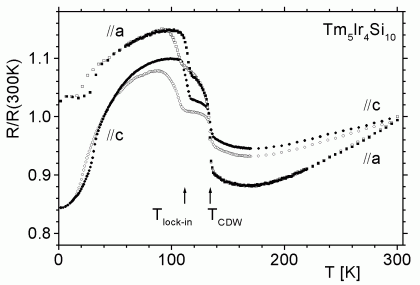
Fig. 4: Temperature dependence of the electrical resistance of Tm5Ir4Si10 along the c-axis (circles) and along the a-axis (squares). The normalized resistance (R(T)/R(T=300K)) is given for cooling (open symbols) and heating (filled symbols). The transition temperatures as obtained by x-ray diffraction are marked by arrows.
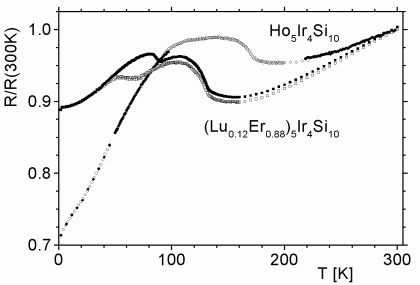
Fig. 5: Temperature dependence of the electrical resistance of polycrystalline bars of Ho5Ir4Si10 (circles) and (Lu0.12Er0.88)5Ir4Si10 (squares). The normalized resistance (R(T)/R(T=300K)) is given for cooling (open symbols) and heating (filled symbols).
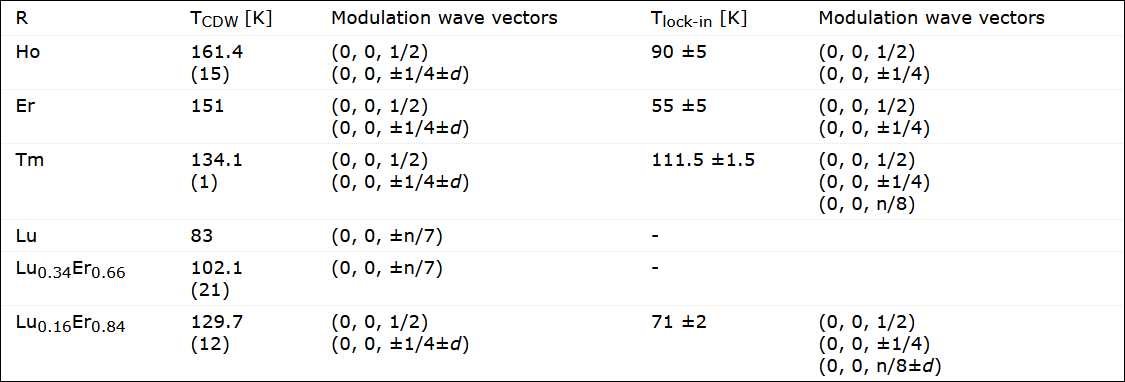
Table 1: Phase diagrams of the compounds R5Ir4Si10 with R = Ho, Er, Tm, Lu, (Lu0.36Er0.64) and (Lu0.16Er0.84). All compounds are tetragonal P4/mbm at room temperature. n denotes an integer; d are numbers in the range of 0.01 to 0.04. Standard deviations are given in parentheses. An accuracy of ±t indicates that incommensurate satellites were observed at Tlock-in+t, and that commensurate satellites were observed at Tlock-in-t.
More experimental results and a more extensive discussion, including a tentative (x,T) phase diagram for (Lu1-xErx)5Ir4Si10, can be found in the publications given below.
Publications:
[1] F. Galli, S. Ramakrishnan, T. Taniguchi, G.J. Nieuwenhuys, J.A. Mydosh, S. Geupel, J. Lüdecke and S. van Smaalen, Phys. Rev. Lett. 85 158-161 (2000). Charge-Density-Wave transitions in the local-moment magnet Er5Ir4Si10.
[2] F. Galli, R. Feyerherm, R.W.A. Hendrikx, E. Dudzik, G.J. Nieuwenhuys, S. Ramakrishnan, S. Brown, S. van Smaalen and J.A. Mydosh, J. Phys.: Condens. Matter 14, 5067-5075 (2002). Coexistence of Charge density wave and antiferromagnetism in Er5Ir4Si10.
[3] S. van Smaalen, M. Shaz, L. Palatinus, P. Daniels, F. Galli, G. J. Nieuwenhuys and J.A. Mydosh, Phys. Rev. B 69, 014103 (2004) (11 pages). Multiple charge-density waves in R5Ir4Si10 (R = Ho, Er, Tm and Lu).
